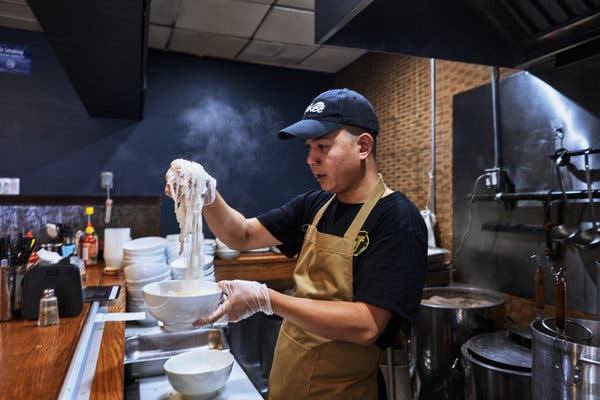On every table at Just Pho stands a jar of dam toi, white vinegar steeped with whole garlic cloves, drifts of chopped garlic and bright, ragged stubs of red chile. Stir it, and the chile seeds swirl.
It’s half-punch, half-sting, and one of the only anointments permitted with the style of pho served here, whose origins — like those of the chef, Trung Nguyen — lie in northern Vietnam.
The pho most Americans know comes from the country’s south, the former home of many Vietnamese refugees who settled in the United States after the war. There, the broth tends to be sweeter than its northern counterpart, more clamorous with flavors, heavier in fragrance and less crystalline. It’s meant to be accessorized, with an accompanying plate of lime, bean sprouts and a boutonniere’s worth of basil, and bottles of hoisin and Sriracha at the ready.

Northern-style pho is almost a rebuke to these distractions. There’s an austere clarity to the broth, which is at once more carnal and more delicate.
“We don’t use Sriracha or hoisin, because our broth is very good,” said Mr. Nguyen, who grew up in Hanoi and has become something of an evangelist for his childhood pho, sometimes going so far as to scold customers who complain about the missing sprouts. (“I defend myself,” he said — although the kitchen will send out lime on request.)
At this minimalist pho shop on a side street across from Pennsylvania Station, he starts his broth by soaking beef and pork bones for hours, to draw out the blood. The pork bones bring a natural sweetness, he said, so you won’t need hoisin later. Then he roasts the bones, painstakingly cleans them again, and puts them in a pot to simmer overnight. There are only two pots — custom-made in Hanoi — and when he sells out of pho, he has to close.
The seasonings in the broth remain unnamed, although he notes that some are hard to find and “produce an extremely strong smell.” Traditionally, Hanoi cooks toss in sa sung, dried marine worms, for a touch of funk.
When Just Pho opened in August, Mr. Nguyen, 31, made the broth “very strong,” adding seasonings at the beginning and again before serving. This proved too much for some non-Vietnamese customers, so he’s eliminated the second dose. But the depth is still there, along with a distinctly animal muskiness.
Each pho comes in two sizes, the smaller of which is already generous.
It’s available with brisket, boiled for several hours in the broth and returned to it at the last minute, juicy and dark. Or diaphanous kerchiefs of eye of round that are slipped raw into the bowl to cook en route to your table, arriving still ruby-hearted and beautifully tender. Or a combination of both, for more texture.
At the start, Mr. Nguyen tried going to each table to cut the beef in front of customers, but quick turnover made that impossible. He obsesses over details, whether training employees to cook the rice noodles — thicker than in southern-style pho — to the exact point of chewiness, or finding the right kind of rice paper, pliant and barely there, for nem ran, spring rolls. The rolls are plump, if slightly overburnished with oil, and obligingly crackle and shatter.
For pho ga xe, Mr. Nguyen stuffs eight whole chickens into a pot, and later shreds the meat. The broth is life-affirming, and the flesh presented alongside slippery skin, the fat half melting. “When you eat KFC, you eat skin and love it,” Mr. Nguyen said. “In Vietnam, we use all different parts of the chicken.”
He has worked at restaurants since he was a 16-year-old student living with a host family in Washington Heights, and spent years as a waiter at the high-end Japanese theme restaurant Ninja in TriBeCa, where he met his business partner, Sonam Tobgay, a native of Bhutan.
Two years ago, on a trip back to Hanoi, Mr. Nguyen became obsessed with a pho vendor near his parents’ house. He asked her to teach him how to make the dish; she refused. Then his mother’s youngest sister put him in touch with a chef — “my master,” he said — willing to share his secrets.
There are a few extras on offer: a wobbling yolk in a separate saucer, to pour into the broth, and a baton of fried dough, for dipping. Note, however, that Mr. Nguyen hasn’t yet found a supplier for the dough that meets his standards. “I’m very picky,” he said.
Follow NYT Food on Twitter and NYT Cooking on Instagram, Facebook, YouTube and Pinterest. Get regular updates from NYT Cooking, with recipe suggestions, cooking tips and shopping advice.




